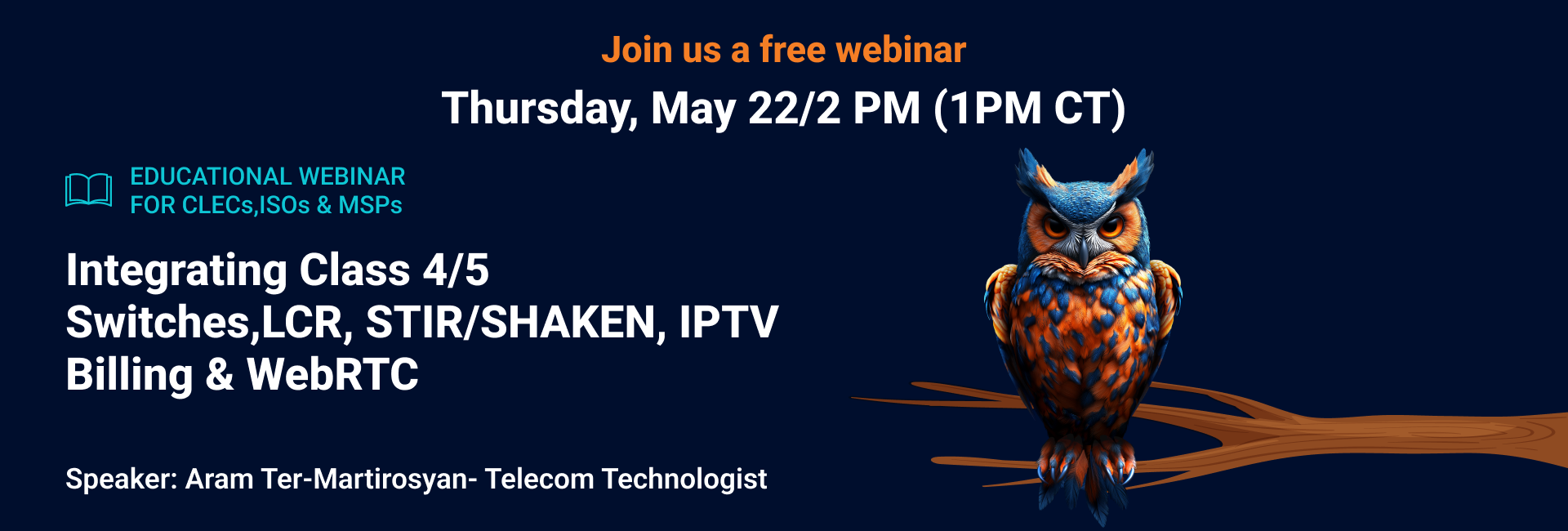OwlUP Events & Webinars
Stay up to date with OwlUP’s upcoming webinars, product showcases, and industry sessions. Explore what’s coming next or catch up on past events.
 Upcoming Events
Upcoming Events 
**Integrating Class 4/5 Switches, LCR, STIR/SHAKEN, IPTV, Billing, and WebRTC for Telecom Services**
Date: Thursday, May 22
Time: 2PM ET/1MP CT)/11 AM PST
1. Introduction (3 Minutes)
- Brief overview of webinar objectives.
- Importance of integrating various telecom components for streamlined operations and cost optimization.
2. Class 4 and Class 5 Switches (8 Minutes)
A. Class 4 Switch Setup (4 Minutes)
- Purpose and Functions: Handling long-distance VoIP traffic and routing.
- Key Steps:
- 1. Hardware/Software Setup: High-performance servers and VoIP platforms.
- 2. Integration with SBCs: Ensuring seamless connectivity.
- 3. Least Cost Routing (LCR): Optimizing call routing for cost savings.
- 4. Security and Monitoring: Implementing monitoring and security protocols.
B. Class 5 Switch Setup (4 Minutes)
- Purpose and Functions: Managing end-user services like PBX and voicemail.
- Key Steps:
- 1. Feature Configuration: Activating advanced telephony features.
- 2. Auto-Provisioning: Streamlined customer account management.
- 3. CRM/Billing Integration: Connecting to customer management systems.
3. Least Cost Routing (LCR) (5 Minutes)
- Purpose: Optimize call routing to reduce costs.
- Key Steps:
- 1. Data Management: Consolidating carrier rate data.
- 2. Policy Setup: Creating cost-effective routing rules.
- 3. Automated Updates: Real-time updates and monitoring.
4. STIR/SHAKEN Implementation (5 Minutes)
- Purpose:Prevent call spoofing and ensure authentication.
- Key Steps:
- 1. Certification: Obtaining necessary digital certificates.
- 2. Configuration: Implementing protocols in the VoIP infrastructure.
- 3. Testing: Ensuring secure call verification.
5. IPTV Platform Setup (5 Minutes)
- Middleware Selection: Choosing compatible platforms for Smart TVs and mobile devices.
- Content Management: Integrating channels and on-demand content.
- User Interfaces: Developing intuitive customer access apps.
6. Telecom Billing System (5 Minutes)
- Automated Billing: Usage-based invoicing and subscription management.
- Payment Integration: Secure online payment options.
- Usage Tracking: Real-time service consumption monitoring.
7. WebRTC System Integration (8 Minutes)
- Purpose: Real-time voice, video, and data communication.
- Key Steps:
- 1. Infrastructure Setup: Deploying media servers and configuring networks.
- 2. Client Development: Building user-friendly web and mobile clients.
- 3. SIP Interoperability: Enabling compatibility with VoIP systems.
- 4. Security: Implementing encryption and user authentication.
- 5. Service Integration: Routing WebRTC calls via Class 4/5 switches, ensuring STIR/SHAKEN compliance, and integrating with IPTV and billing.
8. Benefits of Comprehensive Integration (4 Minutes)
- Unified Communication: Combining voice, video, messaging, and IPTV.
- Cost Optimization: Reducing operational costs through LCR and WebRTC.
- Enhanced Security and Scalability: Secure, adaptable communication solutions.
- Improved User Experience: Integrated CRM, provisioning, and self-service.
9. Q&A (5 Minutes)
- Addressing participant questions.
- Sharing quick examples and practical insights.
10. Conclusion (2 Minutes)
- Recap of key takeaways.
- Encouragement to explore comprehensive integration strategies.
- Information on additional resources and follow-up support.
